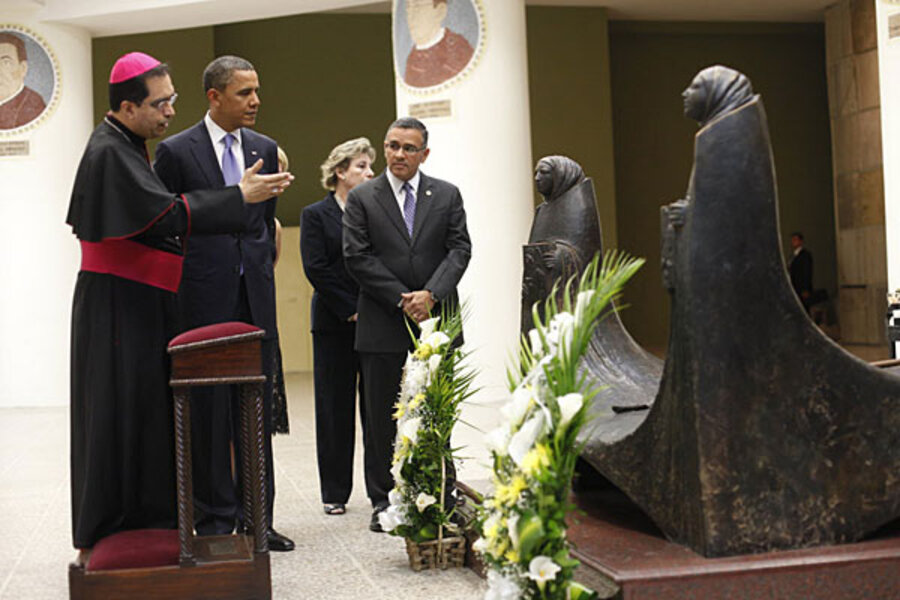A year of drift in US-Latin American relations
Loading...
In March, US President Barack Obama took his first trip to Latin America, stopping off in Brazil, Chile, and El Salvador. In October, the US approved long-awaited free trade deals with Panama and Colombia. According to the 2011 Latinobarometro poll, carried out across 18 countries in the region, President Obama ranked as the most popular leader in the Americas.
This year should have been a stellar one for US-Latin America relations, a major step forward after years of setback. But instead, despite the many positive developments, the relationship is characterized by, if not disdain, then definite distance.
“I think it’s a curious moment,” says Michael Shifter, president of the Inter-American Dialogue in Washington. “There is no evidence of great acrimony in US-Latin American relations as there was four or five years ago. But at the same time, there is this sense of distancing and drift, especially between the US and South America.”
The greatest symbol of that is the regional body that was officially launched in December, called the Community of Latin American and Caribbean States (CELAC), which includes 33 countries across the Americas but specifically excludes the US and Canada.
Many members of the body are strong allies of the US, but long-time foes such as Venezuelan President Hugo Chavez have said they hope it counters the other major regional body, the Organization of American States (OAS), based in Washington.
Such old-time arguments still flare. President Chavez, for example, has been weakened at home, as the country’s opposition strengthens ahead of 2012 presidential elections. In theory, that is good for the US, and the rhetoric between the two has been low-key this year. But it just flared again, with Obama sharply criticizing the state of human rights in Venezuela and the country’s relationship with Iran.
“We're concerned about the government's actions, which have restricted the universal rights of the Venezuelan people, threatened basic democratic values, and failed to contribute to the security in the region," Obama wrote in response to questions posed by the Venezuelan newspaper El Universal.
He added that he believes Venezuela’s relationship with Iran has not served the interest of Venezuelans. “Ultimately, it is up to the Venezuelan people to determine what they gain from a relationship with a country that violates universal human rights and is isolated from much of the world,” President Obama said. “Here in the Americas, we take Iranian activities, including in Venezuela, very seriously and we will continue to monitor them closely.”
Chavez countered on state television: "Obama, take care of your own business, focus on governing your country, which you've turned into a disaster. Leave us alone.”
Venezuela’s relationship with Iran is among the most contentious foreign policies issues within the US-Latin American dynamic but other relationships rankle too. The Cuban government, for example, decreed three days of mourning this week in the wake of the death of North Korean leader Kim Jong-il. They joined Venezuela and Nicaragua in expressing condolences.
But in general, the positive has outweighed the negative this year. Perhaps the US’s strongest ally in the region right now is Mexico, where its strategy against organized crime, despite questionable success, is vociferously supported in Washington. The US continues to underline its support.
The trade deal signed with Panama and Colombia strengthens US economic ties to both countries. And the US has restored relations with the economic powerhouse in the region – Brazil. (Trouble had started to brew over former Brazilian president Luiz Inacio Lula da Silva’s relationship with Iranian President Mahmoud Ahmadinejad.)
Still, on balance, the US is no closer to Latin America than it’s been since 9/11, when attention shifted to terrorism and away from the issues most Latin Americans care about, especially immigration. The region’s favorable view of the US has grown, from 58 percent in 2008 to 72 percent in 2011 (down slightly from a high of 74 percent in 2009), according to the 2011 Latinobarometro poll. The slight dip can be explained by a boost in expectations for Obama after former US President George W. Bush left office – he was widely reviled in Latin America. But even under Obama issues like immigration and drugs have been stuck. There is little hope of them getting “unstuck” in the upcoming US election year.
More than anything, however, is the simple fact that the US is no longer the sole player for Latin America. Obama's March trip was billed by the media as an effort to recapture US influence in Latin America. But Latin America has moved on. Countries are looking amongst themselves and much farther, particularly to China, to bolster their economies. They are forming their own relationships with countries, whether the US likes it or not. Of course US foreign policy matters here, but it matters so much less than it used to.
“There is just a sense that Latin America is pursuing its own agenda,” says Mr. Shifter.





